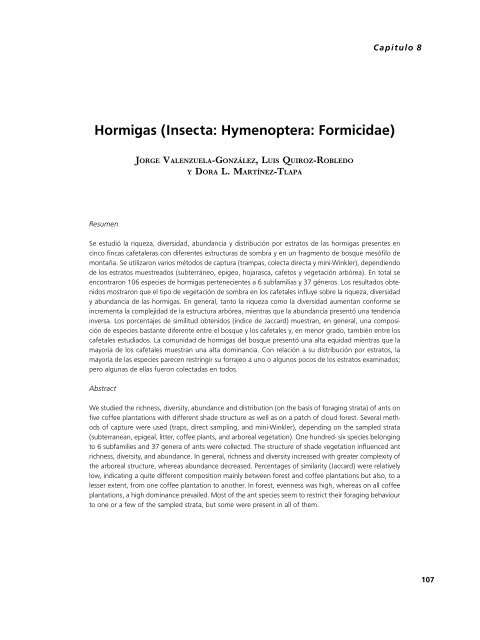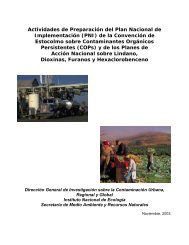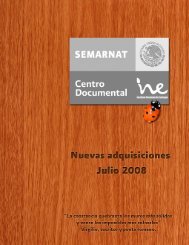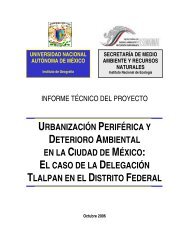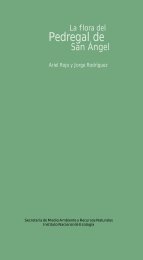- Page 4 and 5:
AGROECOSISTEMAS CAFETALEROS DE VERA
- Page 6 and 7:
ContenidoPresentación . . . . . .
- Page 8 and 9:
PresentaciónMéxico está experime
- Page 10 and 11:
PrólogoAl inicio del siglo XXI, la
- Page 12 and 13:
AgradecimientosEsta obra se enrique
- Page 14 and 15:
Directorio de autoresInvestigadores
- Page 16:
Guadalupe Williams Linera (Investig
- Page 19 and 20:
IntroducciónEl estudio de la agric
- Page 21 and 22:
et al. 1987, Manson datos no public
- Page 23 and 24:
Figura 1.1. Número de publicacione
- Page 25 and 26:
Censos de Población y Vivienda (IN
- Page 27 and 28:
Bartra A. 2004. Mesoamericanos: rec
- Page 29 and 30:
Mas AH, Dietsch TV. 2004. Linking s
- Page 31 and 32:
Stadtmüller T, Agudelo N. 1990. Am
- Page 33 and 34:
Introducción¿Por qué es necesari
- Page 35:
Cuadro 2.1. Datos generales de las
- Page 38 and 39:
Cuadro 2.3. Descriptores socioecon
- Page 40 and 41:
Cuadro 2.4. Ordenación de las 18 f
- Page 42 and 43:
arbóreos y la plantación de cafet
- Page 44 and 45:
Figura 2.4. Ordenación de las finc
- Page 47 and 48:
cadas de modo convencional y a gran
- Page 49 and 50:
de productores y el esfuerzo para f
- Page 51 and 52:
_____. 1999. Biodiversity conservat
- Page 53 and 54:
with coffee growers during a three
- Page 55 and 56:
1) Políticas neoliberales. El Esta
- Page 57 and 58:
(Sistema Integral de Información A
- Page 59:
El trabajo tuvo la siguiente mecán
- Page 63 and 64:
Cuadro 3.2. Reuniones de productore
- Page 65 and 66:
trabajo interdisciplinario y el ent
- Page 67 and 68:
misión Veracruzana de Comercio (CO
- Page 69 and 70:
Chayanov A. 1985. La organización
- Page 71 and 72:
Ysunza A (coord.). Salas M, Contrer
- Page 73 and 74: IntroducciónLos cafetales forman u
- Page 75 and 76: Cuadro 4.1. Riqueza y estructura de
- Page 77 and 78: Figura 4.1. Curvas de rarefacción
- Page 79 and 80: esos criterios son básicos para qu
- Page 81 and 82: Apéndice 4.1. Densidad (individuos
- Page 83 and 84: Apéndice 4.1. Densidad (individuos
- Page 85 and 86: Apéndice 4.1. Densidad (individuos
- Page 87 and 88: IntroducciónEl bosque mesófilo de
- Page 89 and 90: observar las semejanzas entre los s
- Page 91 and 92: Cuadro 5.2. Índice de Similitud de
- Page 93 and 94: Figura 5.2. Análisis de componente
- Page 95 and 96: Lessons for the conservation of tro
- Page 97 and 98: Apéndice 5.1. Especies de epífita
- Page 99 and 100: Apéndice 5.1. Especies de epífita
- Page 101 and 102: IntroducciónLos helechos comprende
- Page 103 and 104: Cuadro 6.1. Riqueza (S) y abundanci
- Page 105 and 106: Cuadro 6.2. Similitud florística d
- Page 107 and 108: Kessler M. 2001. Pteridophyte speci
- Page 109 and 110: Apéndice 6.1. Abundancia (= númer
- Page 112 and 113: Capítulo 7Moscas (Insecta: Diptera
- Page 114 and 115: ONZ = La Onza: cafetal con sombra d
- Page 116 and 117: Figura 7.1. Análisis discriminante
- Page 118 and 119: invierno (Figuras 7.3 y 7.4). Estas
- Page 120 and 121: Figura 7.5. Dendrograma de similitu
- Page 122: Apéndice 7.1. Listado de las famil
- Page 127 and 128: Con el fin de evaluar la eficiencia
- Page 129 and 130: Cuadro 8.2. Porcentajes de similitu
- Page 131 and 132: Figura 8.3. Gráficas de rango-abun
- Page 133 and 134: fincas, pero no se aprecia ninguna
- Page 135 and 136: Mackay W, Mackay E. 1989. Clave de
- Page 137 and 138: Apéndice 8.1. Distribución y frec
- Page 140 and 141: Capítulo 9Escarabajos (Insecta: Co
- Page 142 and 143: Material y métodosLos muestreos se
- Page 144 and 145: Figura 9.1. Curvas de dominancia/di
- Page 146 and 147: Figura 9.4. Grupos funcionales de l
- Page 148 and 149: considerando los tres estratos (sue
- Page 150 and 151: Apéndice 9.1. Familias de Coleopte
- Page 152 and 153: Capítulo 10Anfibios y reptilesAlbe
- Page 154 and 155: y fuera del cafetal (Nestel 1995, P
- Page 156 and 157: Cuadro 10.1. Herpetofauna registrad
- Page 158 and 159: Cuadro 10.3. Matriz de complementar
- Page 160 and 161: Perfecto I, Armbrecht I. 2003. The
- Page 162 and 163: Apéndice 10.1. Anfibios y reptiles
- Page 164: Apéndice 10.1. Anfibios y reptiles
- Page 167 and 168: IntroducciónEl café de sombra es
- Page 169 and 170: ISJ = c/a + b - cdondea = especies
- Page 171 and 172: Cuadro 11.2. Número de especies co
- Page 173 and 174:
son sustituidas por especies genera
- Page 175 and 176:
Apéndice 11.1. Número de individu
- Page 177 and 178:
Apéndice 11.1. Número de individu
- Page 179 and 180:
epresenting 60% of the 55 species r
- Page 181 and 182:
alta diversidad del estrato arbóre
- Page 183 and 184:
(H-P), los que se alimentan en su m
- Page 185 and 186:
Figura 12.1. Curva de acumulación
- Page 187 and 188:
Figura 12.3. Relación negativa sig
- Page 189 and 190:
o el paisaje en que se encuentran,
- Page 191 and 192:
Figura 12.5. Número de especies de
- Page 193 and 194:
Recomendaciones• Si se busca cons
- Page 195 and 196:
Lista de especies en riesgo. Diario
- Page 197 and 198:
Apéndice 12.1. Mamíferos pequeño
- Page 199 and 200:
IntroducciónLa transformación del
- Page 201 and 202:
es y posteriores. Para evaluar si l
- Page 203 and 204:
Figura 13.2. Curvas observadas de a
- Page 205 and 206:
Figura 13.3. Dendrograma que ilustr
- Page 207 and 208:
AgradecimientosAgradecemos a Guille
- Page 209 and 210:
Apéndice 13.1. Número de murciél
- Page 211 and 212:
IntroducciónEn el suelo converge u
- Page 213 and 214:
saprobios indicada como el número
- Page 215 and 216:
Figura 14.1. Valores de abundancia
- Page 217 and 218:
Figura 14.2. Dendrogramas de simili
- Page 219 and 220:
ducir una alta cantidad de esporas
- Page 221 and 222:
Apéndice 14.1. Lista de especies d
- Page 223 and 224:
Apéndice 14.1. Lista de especies d
- Page 225 and 226:
Apéndice 14.1. Lista de especies d
- Page 227 and 228:
Apéndice 14.1. Lista de especies d
- Page 229 and 230:
Apéndice 14.2. Lista de especies d
- Page 231 and 232:
IntroducciónUn agroecosistema sust
- Page 233 and 234:
alta calidad respecto al fósforo c
- Page 235 and 236:
Cuadro 15.3. Propiedades físicas d
- Page 237 and 238:
herbácea controlada, residuos org
- Page 240 and 241:
Capítulo 16Almacenamiento de carbo
- Page 242 and 243:
Es necesario poder medir la biomasa
- Page 244 and 245:
Cuadro 16.2. Características físi
- Page 246 and 247:
para fines de este estudio, el cál
- Page 248 and 249:
el occidente de Ecuador, las cifras
- Page 250:
Oelbermann M, Voroney RP, Gordon AM
- Page 253 and 254:
ing ASTM guidelines). The wood of i
- Page 255 and 256:
m, límites mínimos establecidos p
- Page 257 and 258:
Cuadro 17.2. Seis especies de árbo
- Page 259 and 260:
Cuadro 17.3. Características tecno
- Page 261 and 262:
Recomendaciones• Tomando como bas
- Page 263 and 264:
pino-encino en los estados de Chihu
- Page 265 and 266:
IntroducciónLa polinización es un
- Page 267 and 268:
de diversidad a sin incluir a esta
- Page 269 and 270:
Cuadro 18.3. Índices de Shannon y
- Page 271 and 272:
Figura 18.4. Valores promedio y err
- Page 273 and 274:
café, lo cual es diferente de lo e
- Page 276 and 277:
Capítulo 19Variación de la biodiv
- Page 278 and 279:
En general, se ha considerado que u
- Page 280 and 281:
considerado fue el total registrado
- Page 282 and 283:
aparecen en el Cuadro 19.1 para el
- Page 284 and 285:
Figura 19.4. Relación entre el gra
- Page 286:
Shankar-Raman TR. 2006. Effects of
- Page 289 and 290:
IntroducciónEntender la magnitud e
- Page 291 and 292:
Resultados y discusionDel total de
- Page 293 and 294:
intermedios del gradiente de manejo
- Page 295 and 296:
Apéndice 20.1. Especies indicadora
- Page 297 and 298:
As rustic and diverse shade polycul
- Page 299 and 300:
saprobios y micorrizógenos). Esta
- Page 301 and 302:
da cualitativamente. Esto permite p
- Page 303 and 304:
La diversidad y su relación con la
- Page 305 and 306:
Figura 21.3. Agrupación de las fin
- Page 307 and 308:
estudio (Fig. 21.2b), lo cual sugie
- Page 309 and 310:
Otra hipótesis subyacente al proye
- Page 311 and 312:
éstos y otros servicios ambientale
- Page 313 and 314:
ajarían dependiendo del nivel de p
- Page 315 and 316:
mentación del productor y la de lo
- Page 317 and 318:
Lasco RD, Pulhin FB, MRN Banaticla.
- Page 319 and 320:
Thiollay JM. 1995. The role of trad
- Page 321 and 322:
incremento en la, 244indicadores de
- Page 323 and 324:
ecosistema boscoso, 4, 161, 261ecos
- Page 325 and 326:
indicadores ecológicos, 272, 273í
- Page 327 and 328:
pequeños 26primarios, 281productos
- Page 332 and 333:
Galería fotográficade los cafetal
- Page 334 and 335:
“Panamacani” (PAN) (polígono r
- Page 336 and 337:
Periconia igniaria. Especie saprobi
- Page 338 and 339:
Laelia anceps “lirio de los árbo
- Page 340 and 341:
Cerambycidae (Coleoptera). Insectos
- Page 342 and 343:
Norops schiedei “chipojo grande
- Page 344 and 345:
Oryzomys alfaroi. Una de las especi
- Page 346 and 347:
Dermanura tolteca “murciélago fr
- Page 348:
AGROECOSISTEMAS CAFETALEROS DE VERA


